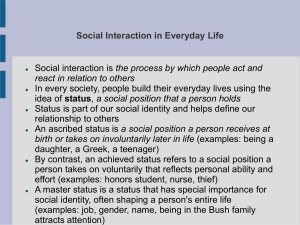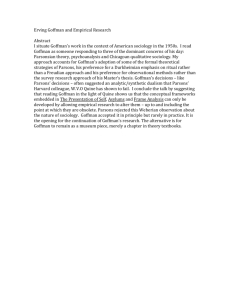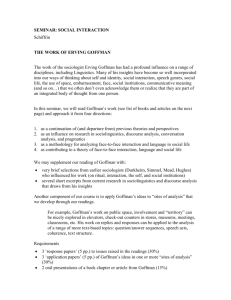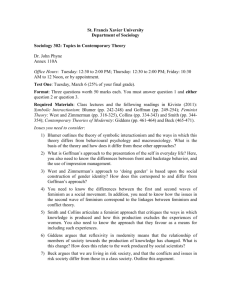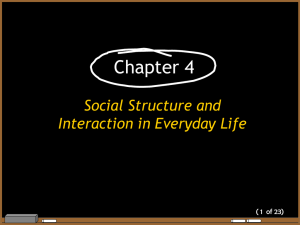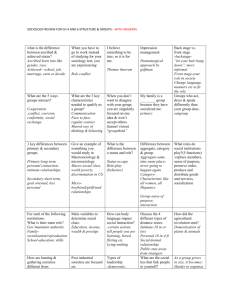Document 10464847
advertisement
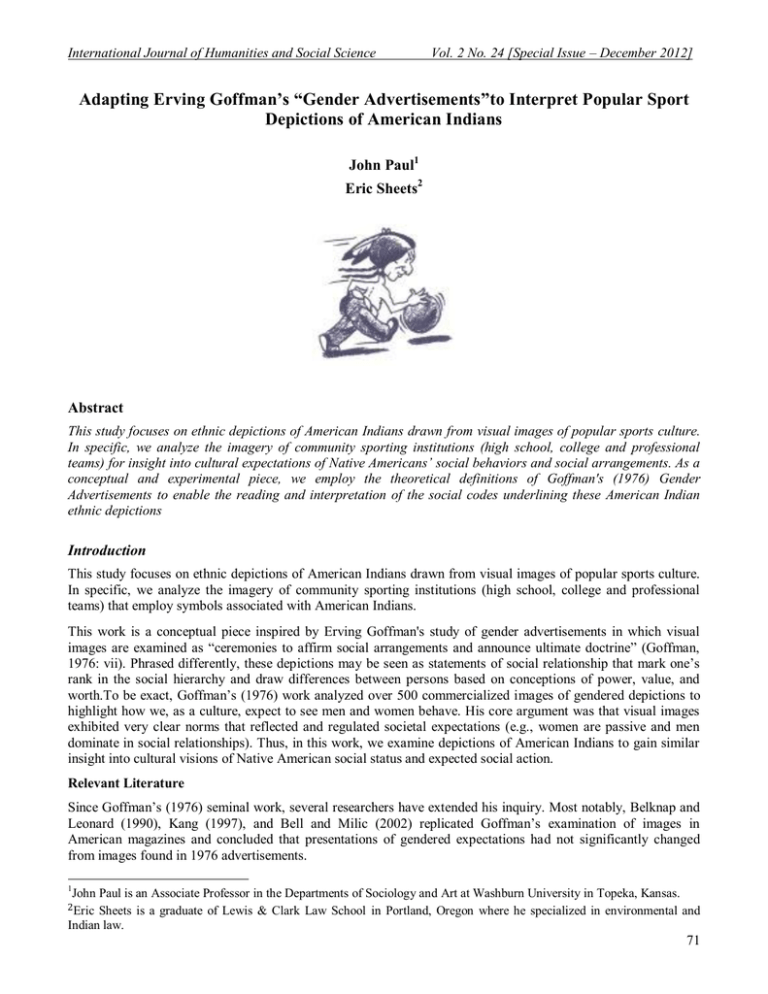
International Journal of Humanities and Social Science Vol. 2 No. 24 [Special Issue – December 2012] Adapting Erving Goffman’s “Gender Advertisements”to Interpret Popular Sport Depictions of American Indians John Paul1 Eric Sheets2 Abstract This study focuses on ethnic depictions of American Indians drawn from visual images of popular sports culture. In specific, we analyze the imagery of community sporting institutions (high school, college and professional teams) for insight into cultural expectations of Native Americans’ social behaviors and social arrangements. As a conceptual and experimental piece, we employ the theoretical definitions of Goffman's (1976) Gender Advertisements to enable the reading and interpretation of the social codes underlining these American Indian ethnic depictions Introduction This study focuses on ethnic depictions of American Indians drawn from visual images of popular sports culture. In specific, we analyze the imagery of community sporting institutions (high school, college and professional teams) that employ symbols associated with American Indians. This work is a conceptual piece inspired by Erving Goffman's study of gender advertisements in which visual images are examined as ―ceremonies to affirm social arrangements and announce ultimate doctrine‖ (Goffman, 1976: vii). Phrased differently, these depictions may be seen as statements of social relationship that mark one‘s rank in the social hierarchy and draw differences between persons based on conceptions of power, value, and worth.To be exact, Goffman‘s (1976) work analyzed over 500 commercialized images of gendered depictions to highlight how we, as a culture, expect to see men and women behave. His core argument was that visual images exhibited very clear norms that reflected and regulated societal expectations (e.g., women are passive and men dominate in social relationships). Thus, in this work, we examine depictions of American Indians to gain similar insight into cultural visions of Native American social status and expected social action. Relevant Literature Since Goffman‘s (1976) seminal work, several researchers have extended his inquiry. Most notably, Belknap and Leonard (1990), Kang (1997), and Bell and Milic (2002) replicated Goffman‘s examination of images in American magazines and concluded that presentations of gendered expectations had not significantly changed from images found in 1976 advertisements. 1 John Paul is an Associate Professor in the Departments of Sociology and Art at Washburn University in Topeka, Kansas. Sheets is a graduate of Lewis & Clark Law School in Portland, Oregon where he specialized in environmental and Indian law. 2Eric 71 Though Japanese images differ from American images they are still gendered in stereotypically patterned ways. In short, genderisms in Japanese television advertising tend to adhere closely to specific rules of The Special Issue on Current Trends in Social Science © Centre for Promoting Ideas, USA www.ijhssnet.com presentation and engagement [established in Japanese society]. Similarly, Holden‘s (2000) work takes Goffman‘s conceptual apparatus to Japanese television advertising and beyond presentations, work of McLaughlin and Goulet (1999) extends likewiseMoving finds that images gender reflect particular societalthe expectations. He (2000:4) writes: Goffman‟s method of “image as social reflection” to examine ethnic depictions. Specifically, McLaughlin andimages Gouletdiffer (1999) modify Goffman‟s to look at ways in which Though Japanese from American imagesthematic they are elements still gendered in stereotypically patterned ways. In short, in Japanese television advertising tendsuch to adhere closely Blacks are presented in genderisms the American media. She (1999:9) argues that images “serveto as a specific rules of presentation and engagement [established Japaneseare society]. social-cultural mirror reflecting the degree whichinBlacks accepted into mainstream culture.” Moving beyond gender presentations, the work of McLaughlin and Goulet (1999) extends Goffman‘s method of ―image as social reflection‖ to examine ethnic depictions. Specifically, McLaughlin and Goulet (1999) modify In this work, we build upon the foundation offered by the aforementioned scholars to further Goffman‘s thematic elements to look at ways in which Blacks are presented in the American media. She (1999:9) portrayal ofa behavioral expectations, ethnicity, andwhich power (viaareGoffman‟s argues explore that such the images ―serve as social-cultural mirror reflecting the degree Blacks accepted into categories) in American Indian ethnic depictions. In the end, we are guided by the words of mainstream culture.‖ In this work, we build upon the foundation offered by the aforementioned scholars to further (1996:10) who arguesexpectations, that Goffman‟s categories “have(via been underused sociologically… exploreSmith the portrayal of behavioral ethnicity, and power Goffman‘s categories) in American and should be a creative platform from which to analyze the vast repositories of visual in Indian ethnic depictions. In the end, we are guided by the words of Smith (1996:10) who argues that data Goffman‘s our culture.” categories ―have been underused sociologically... and should be a creative platform from which to analyze the vast repositories of visual data in our culture.‖ Image 1: 1:The TheMetaphoric Metaphoric Transition Image Transition The second author photographed “Princess Ivana Suck...” at a Professional Football game. We have included this image as a metaphoric transition between Goffman’s (1976) examination of “women as objects” and our investigation of Native American imagery as Mascot usage. Theoretical Framework Sociologists have long held that visual depictions ―reflect how people organize their society, identify what they value as sacred or simply enjoyable, and for what they despise‖ (Kornblum 1994:28). Sociological investigations of this form often reflect upon semiology, that is, the use of signs and symbols to construct meaning and communicate messages to people (Sage 1996). As Bergsen (1984:187) notes, ―Visual symbols are a language. They are therefore decipherable into...codes that carry and communicate social information.‖ In this sense then, symbols may be studied as to their public recognition of social relationships and collective meanings. Sociological studies of this nature include: (1) the examination of speech patterns (vocabulary, accent, pronunciation, annunciation, tone) as markers of social class (Mills 1939; Goffman 1959; Bourdieu 1977, 1991); (2) the display of consumption patterns (leisure activities, home and fashion decoration, choice of food, drink, art) as symbols of distinction and interactive power (Warner 1959; Veblen 1973; Bourdieu 1984); and (3) the role of symbols in creating and enforcing interactive boundaries (Goffman, 1976; Sniderman and Tetlock, 1986; McIntosh 1988; Staurowsky 2000, 2007; Paul and Birzer 2004). Stated simply, symbols and visual images have much to tell us about the nature of our society and social relationships. 72 International Journal of Humanities and Social Science Vol. 2 No. 24 [Special Issue – December 2012] To explore said social arrangements regarding ethnic depictions of American Indians, the theoretical definitions of Goffman's Gender Advertisements (1976) have been purposively adapted as a tool for reading and understanding the semiotic codes underlining them. Specifically, Goffman‘s (1976) framework is organized around six themes of investigation: (1) Relative Size. One way in which social weight (e.g., power, authority, rank) is echoed is through the depiction of relative size, especially height. (2) Functional Ranking. Functional ranking is conveyed when one person is cast in the role of ―executor‖ or the principle player, while an interactive partner is cast in a secondary or supporting role. This category conveys information regarding the social importance and social hierarchy of the participants. (3) Ritualization of Subordination. A classic visual statement of subordination is that of lowering oneself physically in some form or other of prostration. Correspondingly, holding the body erect and the head high is a mark of superiority and disdain. (4) Touch.Goffman (1976) argues that the depiction of touch or the use of one‘s hands reflects both utilitarian and symbolic meaning. In his words: Women, more than men, are pictured using their fingers and hands to trace the outlines of an object or to cradle it or to caress its surface or to effect a ‗just barely touching.‘ This ritualistic touching is to be distinguished from the utilitarian kind that grasps, manipulates, or holds (Pg. 16). Goffman felt that this conveyed the societal idea that women‘s bodies were considered delicate and their behavior passive, while men were forceful and active. (5) Licensed Withdrawal.Licensed withdrawal occurs when a person in a visual setting seems to be physically or psychologically removed from the present situation, thus leaving the impression that they are socially dependent upon others. (6) The Family. A family is commonly defined as a social unit who has common goals, values, and shared commitments to one another. Goffman (1976) argued that images of ―family‖ reflected societal ideal-types or constructions of what people identified as their highest moral ideals (e.g., social unity, love, social bonding). Here, we compare the interactive depictions of American Indians for insight into social weight, cues of functional ranking and/or disdain (as modeled by the first three aforementioned themes). We also look for signs of American Indian behavioral expectation (as reflected through touch), and finally we examine images of collective participation by social units as insight into ideal ―family‖ or societal values. Method Collection Before our analysis of American Indian sports imagery commenced, we had to first identify a collection of symbolic forms from which we could draw. Our collection was facilitated in the melding of five central documents naming sport teams who used American Indian symbolism. The first two documents are the National Coalition on Racism in Sports and the Media (NCRSM, 1999) and American Indian Sports Team Mascot Organization (AISTM, 2005; 2010). In these reports the NCRSM and the AISTM offer a collection of primary and secondary schools in the United States that use Native American imagery as sports mascots (N=2000+). The National Collegiate Athletic Association report on the use of Native American images at colligate championship events (NCAA, 2005) provides our third document. In this work, eighteen colleges and universities are identified as ―holders‖ of Native American imagery and thus become sites for our semiotic investigation. Ourfinal source for Native American sports imagery comes from an open Internet exploration using the search engines Google ©,Bing ©, and Yahoo ©. Specifically, we searched the Internet for imagery using the words ―Indian Sports Mascots‖ to complete our collection (N=300+). Please note that all of the non-photographic images presented here were “copied‖ from open source Internet sites and ―pasted‖ as data in our paper. Open source sites generally refer to data portals that promote access to the origins of its products (see: http://en.wikipedia.org/wiki/Open_source). 73 The Special Issue on Current Trends in Social Science © Centre for Promoting Ideas, USA www.ijhssnet.com While images on open source sites may be bound by copyright, all of the images copied and pasted here are available for public distribution, and to the best of our knowledge, are free of copyright restrictions (see endnotes for further clarification and argument of fair use). 1 Sampling and Analysis Following the location and retrieval of relevant information (i.e., physically visiting and photographing selected sites and/or copying and pasting Native American visual imagery from the Internet), the authors made a broad ―sampling‖ of the material. Sampling refers to ―the skimming of material‖ to cut extraneous and/or irrelevant sources of information (Glassner and Corzine, 1980:305). Specifically we cut hundreds of repetitive images and visual forms that did not meet the established criteria (e.g. images had to reflect American Indian ethnic depictions drawn from popular sports culture). After skimming the data sources, we made a thematic coding of the remaining images based on our reading of the theoretical frameworks conceived by Goffman (1976). Presentation We present a collection of eight ―visual college essays‖ (made from a purposive sampling of 40 separate images) that best represent the totality of images collected and best communicate the thematic concerns of Goffman‘s concepts. Further, following Goffman‘s original image presentation style, we also bracket our collected images ―accompanied informally by some verbal text‖ (1976:24). Themes Relative Size and Social Weight Goffman (1976) contended that the visual expression of social weight (the granting of respect, honor, and dignity) is often reflected in relative size, especially height. He states, ―It is assumed that differences in size will correlate with differences in social weight that relative size can be routinely used as a means of ensuring that the viewer will understand relationships of [interactive power]‖ (p.28). When it comes to the use of Native American sports imagery, said images are often crafted to represent power, strength, and immense social weight. Consider the words of sports columnist Charles Barnes (2001:10), ―No athletic team chooses a name or mascot in order to bring contempt or disrepute on itself...they depict Indians and by extension themselves as noble, courageous, and fierce.‖ However, as Goffman (1976:28) continues, ―Exceptions that prove the rule include individuals thoroughly costumed as craft-bound servitors who-it might appear-can be safely treated within the circumscribed terms [of their appearance].‖In this sense, though the American Indian mascot may initially reflect power, its underlying form may actually be read as a visual signature that reads ―clown, entertainer, savage.‖ Visual Collage 1: Representations of “Social Weight” The i mage cannot be displayed. Yo ur comp uter m ay not have enough mem ory to open the i m age, or the im age m ay have been corrupted. Restart your com puter , and then open the fi le again. If the red x still app ears, you m ay have to delete the im age and then inser t it again. T h e im a g e c a n n o tb e d is p la y e d .Y o u rc o m p u te rm a y n o th a v e e n o u g h m e m o r y to o p e n th e im a g e ,o rth e im a g e m a y h a v e b e e n c o r r u p te d .R e s ta r t y o u rc o m p u te r ,a n d th e n o p e n th e fi le a g a in .I fth e r e d x s tilla p p e a r s ,y o u m a y h a v e to d e le te th e im a g e a n d th e n in s e r tita g a in . A common tactic used to establish superiority is the depiction of size. However, though these images are colossal, they are also clownish and harlequin-like which, in the end, negates their presence of strength. 74 International Journal of Humanities and Social Science Vol. 2 No. 24 [Special Issue – December 2012] Functional Ranking Functional ranking is conveyed when one person is cast in the role of an ―executor,‖ or a position of power and respect, while an interactive partner is cast in a secondary or supporting role. Goffman (1976) argues that such images reflect social conceptions regarding the social importance and social hierarchy of the persons visualized. In a fashion similar to the expression of social weight, the functional ranking of most American Indians (as sports images) reflect both power and disdain. Phrased differently, Native American representations are generally chosen by non-Natives because they are seen to reflect courage, pride, and ferocity. However, of concern here is the notion that American Indian symbolism is typically selected by outsiders for generic purposes. Such images are not generally authentic to the particular cultures from which they are acquired (Black 2002). Thus the cooptation and use of such images reflect disdain for the cultures of origin. As cultural curator Joanna Bedard (1992:5) comments: understanding to categories which debase or ridicule. Such sym representations but caricatures. What happens to a culture whose symbols are chosen by outsiders, by those who do not understand its deepest beliefs, structures and ways of life? What kind of interpretation of a society can come from symbols designed not to elevate conscious understanding to the highest of that society‘s ideas but to reduce that understanding to categories that debase or ridicule. Such symbols are not representations but caricatures. Visual Collage 2: “Functional Ranking” in Word and Ima Visual Collage 2: “Functional Ranking” in Image and Word ! Native American sports imagery is often contradictory regarding presentations of value. On the one hand, images may reflect a noble and exalted presence (as modeled by the image of the left). One the other hand however, images may also rank American Indians as bestial, uncivilized, or savage. !! Native American sports imagery is often contradictory regarding presenta the onewhen hand, images may reflect exalted presence (as Stated differently, a group‘s racial and ethnic qualities a arenoble held by and an outside body, such formulations livemodeled as structures of tacit or symbolic racism originally articulated by Sears and Kinder either end). Oneracism. the Symbolic other hand however, images may also(1971) rankrefers American to the normalization of beliefs of racial superiority (and inferiority) through commonplace language and everyday uncivilized, or savage. cultural artifacts. Take for instance the prevalent use of the word savages in the above visual collage. The National Coalition on Racism in Sports and the Media (1999) report that approximately 89 primary and secondary schools in the U.S. use the ―Savages‖ or ―Redskins‖ as sports logos. Currently, one college team identifies as the ―Savages‖ (NCAA, 2005), and one professional team labels themselves the ―Redskins‖ (nfl.com). Indeed, such labels conceptualize symbolic racism, as the term savage is commonly defined as ―a person regarded as primitive or uncivilized, ―while the term redskin identifies‖ offensive slang used as a disparaging term for a Native Americans‖ (www.dictionary.com). 75 The Special Issue on Current Trends in Social Science © Centre for Promoting Ideas, USA www.ijhssnet.com As Jensen (1994) notes, the rule that sports teams have a right to name themselves needs to take into account power, effects, and authenticity; not everyone has the right to claim any name. He states: In the case of teams who identify as Savages or Redskins, a non-Indian group (the team) has exercised its power to use a derogatory name that likely has harmful effects in promoting racist stereotypes--a name to which the team has no authentic claim. The team is appropriating a racist term that has been used against an oppressed group (1994:2). We argue that these symbolic forms help to produce and maintain inequality by offering an institutionalized vision of supremacy. The everyday images, which make use of stereotypes, act to remove said persons from the mindsets of others. Stated differently, when a group is stereotyped, they are removed from acts of cognition, which then make certain actions toward the group justifiable. Fiske (1993:623) argues: Stereotypes control people, which is one of the reasons they are so aversive...Stereotypes reinforce one group‘s or individual‘s power over another by limiting the options of the stereotyped group, so in this stereotypes maintain power. People with power do not have to put up with them, but people without power are victims. Power is control and stereotypes are one way to exert control both social and personal. Ritualization of Subordination A classic visual statement of subordination is the lowering of oneself physically in some form or another. Correspondingly, holding the body erect and the head high is a mark of superiority. As Goffman (1976) notes, the configurations of postures can be read as an acceptance of subordination or an expression of superiority. Visual Collage 3: Chiefs as Mascots Chief Osceola of Florida State Chief Illiniwek2 Chief Big Track of Arkansas State ! Again, Native American sports images are often contradictory in value. Consider the juxtaposition of the following terms: A Chief is commonly defined as a person of prominence, while a mascot is a charm or a fetish crafted to bring its owner luck. Stated in another manner, mascots are objects owned while Chiefs are leaders above the commands of others. In the visual collage identified above, the symbols of Native America reflect prominence, as they are the center of public attention. However the reverence that is offered is also ―misrecognized disdain‖ for this honor is wrapped in ignorance. Black (2002:607-608) writes: 76 International Journal of Humanities and Social Science Vol. 2 No. 24 [Special Issue – December 2012] The University of Illinois, for example, loads its token Chief Illiniwek with traits not associated with the Illini leader. The university employs a generic stereotype of Indianness to conquer the particular heritage of the Illini... And Florida State appropriates the historical Chief Osceola and Seminole tribe through known cultural artifacts like eagle feathers and chickees. The university, however, also lumps into the Seminole image inaccurate war chants, tomahawks, crooked noses, smoke signals, tepees, leather-fringed pants and western movie-style drums. Further, Arkansas State‘s image of Chief Big-Track, named after Osage Chief Cashesegra (translated to mean Big Foot or Walks with Big Track--Chronicles of Oklahoma 1942), is a fabrication with no historical reference. Consider the words of two former ASU students on playing Chief Big-Track: One male student reported, ‗Every time the football team made a touchdown, Chief Big Track ran the track, That's how he got his name. He would mount his horse and make a full run around the track. Student two, a female, stated, ‗I was Princess (a secondary member of the ASU Indian mascot family) for two years, and then I got smart. I like to act crazy, do a lot of jumping. I couldn't do that in the princess dress. So I later revived the role of Chief Big-Track. As the chief, I invested my own money and time in maintaining the costumes. I even bought my own makeup and accessories. One year, I had pictures made of me in costume. I autographed them and handed them out at the games‘ (Beveridge, no date). In summary, the general imagery of these Indian Chiefs are Euro-American creations born of misinformation and generalized stereotypes (Black 2002). The problem with this is that these creations never allow us to see actual Indians. Stereotypes negate our awareness of Native history, worldviews, and structural conditions – and this alone may be considered a ritual of neglect and subordination. Head Trophies: Constructing the Generic Indian Bridging the above themes includes the creation and use of ―Native heads‖ as group totems. Very generally, a totem is the material representation of the interactive codes preferred by a group or society (Tanner, 2003:35). Stated in another manner, a totem is a symbol that models the expected social behavior for group members. As Ames (1986:9) notes: [The totem] may be used to express and authenticate the established or official values of images of a society in several ways, directly, by promoting and affirming the dominant values, and indirectly, by subordinating or rejecting alternative values. To reiterate the words of Barnes (2001:10), a Native totemic image is chosen to model group identity and collective values such as ―nobility, courageousness, and ferocity.‖ Consider however, the caricatured images (e.g., stereotypical feathers and enlarged noses) in most of the images presented below. What is being said about the identity of the mascot? Is it a respectful representation of a noble and courageous figure or a mockery of a group that has been marginalized socially, economically, and politically for five centuries (Josephy, 1999)? Further, our critical commentary notes again that most totems chosen by cultural outsiders reflect, not native identity, but generalized stereotypes. Thus, the totemic values and behaviors modeled by these head trophies identify conquest and overall ignorance of Native cultures. To make this last point concrete, consider Fixico‘s (2005) disturbing history of Chief Osceola's demise: On January 30, 1838, the famed Seminole leader died as a prisoner of war. [The Dr. who presided over his death] had the corpse beheaded and laid claim to many of Osceola's personal possessions and clothes. Osceola's head passed through several hands until 1843, when it came to Dr. Valentine Mott, who put it on display and later donated it to the Medical College of New York. It disappeared following a fire in 1865 (Fixico 2005:2). 77 The Special Issue on Current Trends in Social Science © Centre for Promoting13Ideas, USA www.ijhssnet.com Visual Collage 4: Head Totems and Trophies Visual Collage 4: Totems and Head Trophies We have chosen the thephrase “head trophies” to acritically (and bitthe sarcastically) play We have chosen phrase “head trophies” to critically (and bit sarcastically) play a upon image of scalping = “a trophy of victory and conquest” (www.dictionary.com). upon the image of scalping = “a trophy of victory and conquest.” Touch Touch With “touch,” Goffman argues that the use of one‟s hands reflect expected social behaviors. In his original work Goffman (1976:16) examined gender and argued that “women, more than men, are pictured using their fingers hands to trace the outlines of an object or to cradle itbehaviors. In his original work With ―touch,‖ Goffman argues that the use ofand one‘s hands reflect expected social or to caress its surface or to effect a „just barely touching.‟” Goffman (1976:16) examined gender and argued that ―women, more than men, are pictured using their fingers Goffman felt that this conveyed the societal idea that women‟s bodies were considered delicate and hands to trace theandoutlines ofpassive, an object toforceful cradle it orIntothiscaress its identify surface or to effect a ‗just barely their behavior while menor were and active. work we too “touch” for signs of behavioral expectation. ! touching.‘‖ Goffman felt that this conveyed the societal idea that women‘s bodies were considered delicate and their behavior passive, while!! men were forceful and active. In this work we too identify ―touch‖ for signs of ! behavioral expectation. Indeed, what we find is more of the same. If ―handwork‖ models societal expectations (as ! Goffman argues it does) then American Indians are again ―typecast‖ into generic warrior roles. Consider the ! following images: ! ! Visual Collage 5: Native American Handwork ! ! The im age cannot b e displayed . Your com puter may not have enough m em ory to open the im age, or the im age m ay have been corr up ted. Restar t your com puter, and then open the fi le again. If the red x still appears, you m ay have to delete the im age and then insert it again. The im age cannot be disp layed. Your com puter m ay not have enough m emory to open the im age, or the im age m ay have been corrupted. Restart your com puter, and then open the fi le again. If the red x still appears, you m ay have to delete the im age and then insert it again. ! ! ! The “Tomahawk Chop” is a common event at sporting events. It is often precipitated or accompanied by a “war chant” or the rhythmic speaking or singing of words or sounds used to encourage the team and/or insult the opposition. If Goffman (1976) is correct in his assumptions about symbols as reflections of societal expectations, then the chop and the war chant both relate to and fuel the perception of the Indian as a warrior. 78 International Journal of Humanities and Social Science Vol. 2 No. 24 [Special Issue – December 2012] Licensed Withdrawal Licensed withdrawal refers to the visual depiction of psychological disengagement. According to Goffman (1976:57) such visual images signify a person who is ―largely un-oriented to the world, and therefore dependent on the protectiveness and goodwill of others.‖ When studying images, Goffman (1976) believed the best way to understand relations between males and females was to compare them to the parent-child relation in which men take on the roles of parents while women behave as children normally would be expected (e.g., women do not make important decisions or do important things, women are dependent and need men's protection, and men regard women primarily as objects). Conceptually, we find similar relationship expectations regarding the depiction of Native Americans and their interactions with the outside world. In specific, we find persons who need to be cared for (and/or need to be spoken for because they are infant like or imbecilic). Truly, the depiction of licensed withdraw has tremendous implications for Native Americans. In particular, licensed withdraw (e.g., depicting Indians as childlike or psychologically absent to the world around them) carries internal justifications for the need of assimilation and acculturation. Stated differently, if Native Americans are viewed as persons helpless to this world, then we treat them as children and tell them what to do in their affairs. Indeed, this has been the general history of relations between American Indians and the U.S. federal government (Debo, 1970; Bordewich, 1997; Josephy, 1999). 17 Visual Collage 6: Licensed Withdraw !!!!!!!!!!!! ! !!!!!!!!!!!! 17 !!!!!!!!!!!! ! ! ! Goffman's (1976) major indicator of withdrawal was the childlike presentation of persons along with the posturing of distance and averted gaze. Please note the structuring of such qualities (e.g., ! mindless or absent look and folded arms) in the overhead images. ! !! ! Goffman's (1976) major indicator of withdrawal was the childlike presentation of persons ! and averted Goffman's (1976) major indicator was childlike presentation o along with the posturing of distance gaze. Please note of thewithdrawal structuring of the such ! along with the posturing distance and images averted gaze. Please note the structurin (e.g., mindless or absent look and folded arms) inofthe overhead The qualities Family ! ! qualities (e.g., mindless or absent look and folded arms) in the overhead images ! ! Goffman (1976) argued that images of ―family‖ reflected societal ideal-types, or constructions of what people ! ! identified as their highest moral ideals (e.g., social unity, love, social bonding). In this work we do indeed find ! ! he Family T ! examples of social unity and societal commemoration captured in visual form. ! The Family Goffman (1976) argued that images! of “family” reflected societal ideal-types, or constructions These of identified joy, celebration, andhighest social bonding would bethat ―heart-warming‖ were social they notbonding). at societal the social Goffman (1976) argued images of “family” reflected ideal-types, o ofexpressions what people as their moral ideals (e.g., social unity, love, of what of people identified asas their highest moral ideals (e.g., social unity, love, so In this work we do indeed find examples unity and societal commemoration captured and psychological expense of the Native American. Bysocial playing Indian, represented in stereotypical forms (e.g., In this we work we do indeed findofexamples social unityfor and in visual images that areform. offense or culturally inaccurate) replicate structures ignoranceofand disdain allsocietal native commemor in visual form. people. In the end, if images of celebration, ―family‖ represent societal ideals, then thebe Indian presentations identified These expressions of joy, and social bonding would “heart-warming” were theyhere These expressions joy, celebration, and social bonding would namenot a group notsocial yet welcomed to the family. at the and psychological expense of theofNative American. By playing Indian, asbe “heart-warm at the socialthat andare psychological the Native American. By play represented in stereotypical formsnot (e.g., images offense or expense culturally we !! of inaccurate) represented stereotypical forms (e.g., images are offense replicate structures of ignorance and disdain in for all native people. In the end,that if images of or culturally ! of ignorance and disdain forname all native people. In the end “family” representofsocietal ideals, then the structures Indian presentations identified here a group ! Goffman's (1976) major indicator withdrawal wasreplicate the childlike presentation of persons “family” represent societal ideals, then the Indian presentations identified here not yet welcomed to the family. along with the posturing of distance and averted gaze. Please note the structuring of such ! not yet welcomed to images the family. qualities (e.g., mindless or absent look and folded arms) in the overhead ! ! ! 79 ! The Family ! Goffman (1976) argued that images of “family” reflected societal ideal-types, or constructions 20 The Special Issue on Current Trends in Social Science © Centre for Promoting Ideas, USA www.ijhssnet.com Visual Collage 8: The Native Image: Play and Protest Visual Collage 7: The Family or Playing Indian The im age cannot be d isplayed . Your com puter m ay not have enough m em ory to open the im age, or the im age m ay have been corr up ted . Restar t your com puter, and then open the fi le again. If the red x sti ll appears, you m ay have to delete the im age and then i nsert it again. Native American sports imagery is often contradictory regarding presentations of value. On the one hand, images may reflect a noble and exalted presence (as modeled by the pictures on either end). One the other hand however, images may also rank American Indians as bestial, uncivilized, or savage. ! Though we recognize that many sports fans create a sense of self through their team’s imagey, we also recognize that said images hold painful reflections for many Natives. Indeed, if Native Americans feel that the team names or logos are insensitive, or at worst racist, shouldn't that be enough for change? ! One of the strongest social identifiers of family is the social bonds and interactive networks through which socialization and passage of knowledge occurs. In the act of playing Indian (in forms that are inaccurate and/or demeaning) we are inadvertently socializing ignorance and potential intolerance through family connections. Summary and Conclusions Using the conceptual framework of Goffman‘s (1976) Gender Advertisements we explored American Indian ethnic depictions drawn from visual images of popular sports culture. In specific, we analyzed the imagery of community sporting institutions (high school, college and professional teams) that employ symbols associated with American Indians 3. Our analysis of Native American sports imagery highlights several critical points. First, these images serve as a socio-cultural mirror reflecting the form by which Native Americans are generally seen and expected to behave in mainstream culture. Indeed, as Morgan (1986:62) notes: 80 Collage 8: The Native Image: Play and Protest Visual Collage 8: The Native Image: Play and Protest Vol. 2 No. 24 [Special Issue – December 2012] International Journal of Humanities and Social Science In our not-too-distant past, grotesque racial caricatures and stereotypes of blacks were accepted in America as an ordinary form of humor [that] served to reinforce white notions of racial superiority. Even the less grotesque representations of blacks as servants or cooks had the same effect, driving home the concept that blacks were suited to menial jobs. The most objectionable of these caricatures are now out of circulation... Though we recognize that many sports fans create a sense of self through their team’s imagey, we also recognize that said images hold painful reflections for many Natives. Indeed, if Native Americans feel that the team names or logos are insensitive, or at worst racist, shouldn't that be enough for change? The problem with this, in our view, is that the general imagery of the ―Indian‖ is a Euro- American creation born With this in mind, we unfortunately note that racial caricatures of Native Americans have not fallen out of circulation, nor have their subsumed cues of racial inferiority disappeared. Thus, we second, argue that the majority of these images are not only stereotypical but also oppressive. In specific, Native American sports images are commonly tied to systems of power in which Non-Natives appropriate Native cultural symbols as their own. 24 of generalized stereotypes. In this light, these creations never allow us to see actual Indians. Stereotypes negate our awareness of Native history, worldviews, and structural conditions – and this alone may be considered statements of ignorance and oppression. Visual Collage 8: The Native Image--Play and Protest ! any sports fans create a sense of self through their team’s imagey, images hold painful reflections for manythat Natives. Indeed,fans if Native Though we recognize many sports create a sense of self through their team’s imagey, m names or logos we arealso insensitive, or at worst racist, shouldn't thatreflections for many Natives. Indeed, if Native recognize that said images hold painful Americans feel that the team names or logos are insensitive, or at worst racist, shouldn't that be enough for change? ! Though we recognize that many sports fans create a sense of self through their team’s imagery, we also ! ! recognize that said images hold painful reflections for many Natives. Indeed, if Native Americans feel that the team names or logos are insensitive, or at worst racist, shouldn't that be enough for change? ! ! ! ! 81 The Special Issue on Current Trends in Social Science © Centre for Promoting Ideas, USA www.ijhssnet.com References American Indian Sports Team Mascots. (2005). “Get Involved Now.” Retrieved from: http://www.aistm.org/getinvolved.htm American Indian Sports Team Mascots. (2010). List of organizations endorsing retirement of “Indian” sports team tokens. Retrieved from http://aistm.org/fr.groups.htm Barnes, C. (2001). ―Animals are Mascots—Seminole Indians Are Symbols‖ Florida State Times September, 2001:10. Bedard J. (1992). Pp. 5, In D. Doxtator, Fluff and Feathers: An Exhibit on the symbols of Indianness. Brantford, Ontario: Woodland Cultural Centre. Belknap, P. and W. Leonard. (1991). ―A Conceptual Replication and Extension of Goffman‘s Study of Gender Advertisements.‖ Sex Roles 25:103-18. Bell, P. and M. Milic.(2002). ―Goffman‘s Gender Advertisements Revisited:Combining Content Analysis with Semiotic Analysis‖ Visual Communication 1:203-222. Bergesen, A. (1984). ―The Semantic Equation: A Theory of the Social Origins of Art Styles.‖ Sociological Theory 2: 187-221. Beveridge, L. (no date). ―ASU Re-Establishes Indian Family‖ Herald University Press. Online: http://herald.astate.edu/herald/archive/news/1018fam.html Black, J. (2002). ―The Mascotting of Native America: Construction, Commodity, and Assimilation‖ The American Indian Quarterly 26:605-618. Bourdieu, P. (1977). Outline of a Theory of Practice. Cambridge, NY: Cambridge University Press. _______. (1984). Distinction. Cambridge: Harvard University Press. _______. (1991). Language and Symbolic Power. Cambridge, MA: Harvard University Press. Bordewich F.M. (1997). Killing the White Man's Indian: Reinventing Native Americans at the End of the Twentieth Century. Anchor Books. Chronicles of Oklahoma. (1942). ―The Three Forks‖ Oklahoma Historical Society. Retrieved from:http://digital.library.okstate.edu/Chronicles/v002/v002p037.html Debo, A. (1970). A History of the Indians of the United States. Norman, OK: University of Oklahoma Press. Fiske, S. (1993). ―Controlling other people: The impact of power on stereotyping.” American Psychologist 48, 621-628. Fixico, D. (2005). ―Osceloa.‖ Encyclopedia of North American Indians. Retrieved from: http://college.hmco.com/history/readerscomp/naind/html/na_026900_osceola.htm Garoian, C. and Y.M. Gaudelius. 2008. Spectacle Pedagogy. Albany, NY: State University Press. Goffman, E. (1959). The Presentation of Self in Everyday Life. New York, NY: Doubleday. ______. (1976). Gender Advertisements. New York: Harper & Row. Guiliano, J. (2011). ―Chasing Objectivity? Critical Reflections on History, Identity, and the Public Performance of Indian Mascots ― Cultural Studies ↔ Critical Methodologies, 11: 535-543. Holden, Todd. (2000). ―I‘m Your Venus/You‘re a Rake: Gender and the Grand Narrative in Japanese Television Advertising‖ Intersections: Gender, History and Culture in the Asian Context Issue 3. Online at: www.sshe.murdoch.edu.au/intersections/issue3_contents.html Jacobs, M.R. and T. Taylor. (2012). ―Challenges of Multiracial Antiracist Activism: Racial Consciousness and Chief Wahoo.‖ Critical Sociology, 38:687-706 Jensen, R. (1997). ―Banning ‗Redskins‘ From the Sports Page: The Ethics and Politics of Native American Nicknames‖ The Journal of Physical Education, Recreation & Dance. 68: 4+ Retrieved from:www.questia.com Josephy, Jr A., J. Nagel and T.Johnson (1999). Red Power: The American Indians’ Fight for Freedom. Nebraska University Press. Kang, M. (1997). ―The Portrayal of Women‘s Images in Magazine Advertisements: Goffman‘s Gender Analysis Revisited‖ Sex Roles 37:979-96. Kornblum, W. (1994). Sociology in a Changing Society. Fort Worth, TX: Harcourt Brace. McIntosh, P. 1988. ―White Privilege and Male Privilege‖ Pp. 94-105 in M. Anderson and P. Hill Collins (eds.), Race, Class, and Gender: An Anthology. Belmont, CA: Wadsworth. McLaughlin, T. and N. Goulet. (1999). ―Gender Advertisements in Magazines Aimed at African Americans: A Comparison to their Occurrence in Magazines Aimed at Caucasians.‖ Sex Roles 40:6+ Retrieved from: www.questia.com 82 International Journal of Humanities and Social Science Vol. 2 No. 24 [Special Issue – December 2012] Mills, C.W. (1939). ―Language, Logic, and Culture.‖ American Sociological Review 4: 670-680. Morgan, H. (1986). Symbols of America. New York, NY: Viking Press. National Coalition on Racism in Sports and the Media. (1999). ―MASCOTS - Listings of Schools by State‖ Retrieved from:: http://www.aics.org/mascot/schools.html National Collegiate Athletic Association. (2005). ―NCAA Executive Committee Issues Guidelines for Use of Native American Mascots at Championship Events.‖ Retrieved from: http://www2.ncaa.org/media Paul, J. and M. Birzer. (2004). ―Images of power: An analysis of the militarization of police uniforms and messages of service.‖ Free Inquiry in Creative Sociology 32:121- 128. Sage, G.H. (1996). ―Patriotic Images and Capitalist Profit: Contradictions of Professional Team Sports Licensed Merchandise.‖ Sociology of Sport Journal 13, 1-11. Sears, D. and D. Kinder. (1971). ―Racial tension and Voting in Los Angeles‖ Pp. 51-88 in W. Hirsh (ed.), Los Angeles: Viability and Prospects for Metropolitan Leadership. New York, NY: Praeger. Smith G. (1996). ―Gender Advertisements Revisited: A Visual Sociology Classic‖ Electronic Journal of Sociology Retrieved from: www.sociology.org/content/vol002.001/smith.html Sniderman, P. M., & Tetlock, P. E. (1986). Symbolic racism: Problems of motive attribution in political analysis: Journal of Social Issues, 42, 129-150. Staurowsky, E.J. (2000). ―The Cleveland ‗Indian‘: A case study in American Indian Cultural Dispossession.‖ Sociology of Sport Journal 17: 307-330._______. (2007). ―You Know, We Are All Indian‖: Exploring White Power and Privilege in Reactions to the NCAA Native American Mascot Policy.‖ Journal of Sport & Social Issues 31: 61-76. Steinfeldt, J.A, Brad D. Foltz, Julie R. LaFollette, Mattie R. White, Y. Joel Wong, and Matthew Clint Steinfeldt. (2012). ―Perspectives of Social Justice Activists: Advocating Against Native-Themed Mascots, Nicknames, and Logos.‖ The Counseling Psychologist, 40:326-362. Veblen, T. (1973). The Theory of the Leisure Class. Boston, MA: Houghton Mifflin Company. Warner, W. L. (1959). The Living and the Dead: A Study of the Symbolic Life of Americans. New Haven, CT: Yale University Press. End Notes 1While all efforts have been utilized to ensure the presentation of copyright free images, we do however claim the use of fair doctrine. One of the rights accorded to the owner of copyright is the right to reproduce or to authorize others to reproduce the work. This right is subject to certain limitations found in sections 107 through 118 of the copyright law (title 17, U. S. Code). One of the more important limitations is the doctrine of ―fair use.‖ The doctrine of fair use has developed through a substantial number of court decisions over the years and has been codified in section 107 of the copyright law. Section 107 contains a list of the various purposes for which the reproduction of a particular work may be considered fair, such as criticism, comment, news reporting, teaching, scholarship, and research. As this work fails within the confines of criticism, scholarship and research, the authors cite the doctrine of fair use in the college and presentation of all images reproduced here. The authors also follow the techniques of ―critical collage pedagogy‖ (Garoian and Gaudelius, 2008), which holds that copyrighted material may be used in a derivative way without permission, if the collected works are combined in such as a way as it can be considered a new work in its own right. We hold that the works combined here into a collage combine a new work in its own right and are thus free of copyright restriction. 2 For more than two decades, Chief Illiniwek was the center of a controversy. At the root of this controversy was the argument that the mascot was a misappropriation of indigenous cultural figures and rituals as well as a stereotype of American Indian peoples. As a result of this public debate, the National Collegiate Athletic Association (NCAA) termed Chief Illiniwek a "hostile or abusive" mascot and image in August 2005and banned the university from hosting postseason activities as long as it continued to use the mascot and symbol. On March 13, 2007, the University of Illinois board of trustees voted to retire Illiniwek's name, image and regalia. However, it is still common for students to portray the chief, although this portrayal is not sanctioned or endorsed by the University. 3Please read, Guiliao (2011); Jacobs and Taylor (2012); and Steinfeldt, etal. (2012) for ongoing critical scholarship into the usage of American Indian mascots at the high-school, collegiate and professional levels. 83
